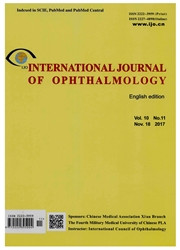

 中文摘要:
中文摘要:
· AIM: To investigate the therapeutic effects of nanophtha- locyanine photosensitizers on an experimental rat choroidal neovescularization (CNV) model, as well as to evaluate the cytotoxicity of which on human retinal pigment epithelia (HRPE) and human retinal endothelial cells (HRECs). · METHODS: Two types of photosensitizers, G1-ZnPc(COOH)8 and G1-ZnPc(COOH)8/m respectively, were administrated for photodynamic therapy (PDT) after a successful establishment of CNV model on Brown-Norway (BN) rats via fundus photocoagulation. The therapeutic effects of the two drugs were assessed through optical coherence tomography (OCT), fluorescein fundus angiography (FFA) and transmission electron microscopy (TEM). For cytotoxicity tests, cell counting kit-8 (CCK-8) assays and changes of mitochondrial transmembrane potential (△Ψm) were conducted on HRPE and HRECs after initial uptake of the two drugs. · RESULTS: Both photosensitizers demonstrated an improve- ment of vascular leakage and closure of CNV 1 week after PDT as confirmed by fundus image, OCT, FFA and TEM. Two weeks after PDT, G1-ZnPc(COOH)8/m showed a better CNV closure effect versus G1-ZnPc(COOH)8 (P 【0.05). A significant difference (P【0.01) was found in uptake of the two drugs in HRPE and HRECs, with no difference between the drugs(P 】0.05). Both photosensitizers showed cytotoxicity on HRPE, but G1-ZnPc(COOH)8/m induced a lower cell viability. · CONCLUSION: G1-ZnPc(COOH)8/m mediated PDT is better than G1-ZnPc(COOH)8 in CNV closure and also have the advantage of fast metabolism leading to less side effect. ·
 英文摘要:
英文摘要:
AIM: To investigate the therapeutic effects of nanophthalocyanine photosensitizers on an experimental rat choroidal neovescularization (CNV) model, as well as to evaluate the cytotoxicity of which on human retinal pigment epithelia (HRPE) and human retinal endothelial cells (HRECs). METHODS: Two types of photosensitizers, G(1)-ZnPc(COOH)(8) and G(1)-ZnPc (COOH)(8)/m respectively, were administrated for photodynamic therapy (PDT) after a successful establishment of CNV model on Brown-Norway (BN) rats via fundus photocoagulation. The therapeutic effects of the two drugs were assessed through optical coherence tomography (OCT), fluorescein fundus angiography (FFA) and transmission electron microscopy (TEM). For cytotoxicity tests, cell counting kit-8 (CCK-8) assays and changes of mitochondrial transmembrane potential (Delta psi m) were conducted on HRPE and HRECs after initial uptake of the two drugs. RESULTS: Both photosensitizers demonstrated an improvement of vascular leakage and closure of CNV 1 week after PDT as confirmed by fundus image, OCT, FFA and TEM. Two weeks after PDT, G(1)-ZnPc (COOH)(8)/m showed a better CNV closure effect versus G(1)-ZnPc(COON)(8)(P<0.05). A significant difference (P<0.01) was found in uptake of the two drugs in HRPE and HRECs, with no difference between the drugs(P>0.05). Both photosensitizers showed cytotoxicity on HRPE, but G(1)-ZnPc(COOH)(8)/m induced a lower cell viability. CONCLUSION: G(1)-ZnPc (COOH)(8)/m mediated PDT is better than G(1)-ZnPc (COOH)(8) in CNV closure and also have the advantage of fast metabolism leading to less side effect.
 同期刊论文项目
同期刊论文项目
 同项目期刊论文
同项目期刊论文
 Proteome changes during bone mesenchymal stem cell differentiation into photoreceptor -like cells in
Proteome changes during bone mesenchymal stem cell differentiation into photoreceptor -like cells in 期刊信息
期刊信息
